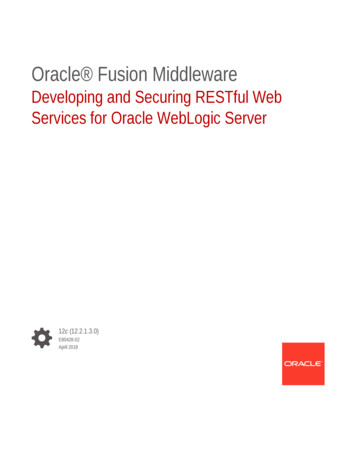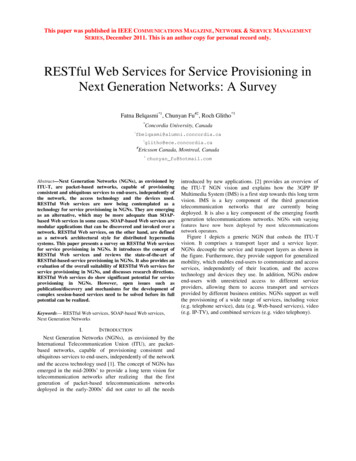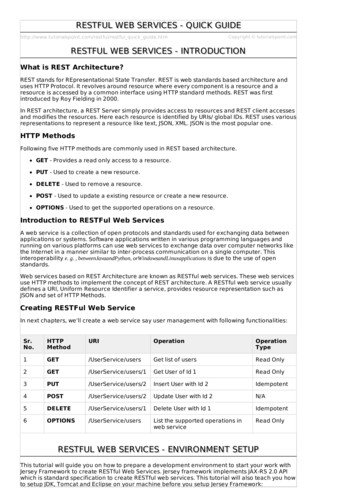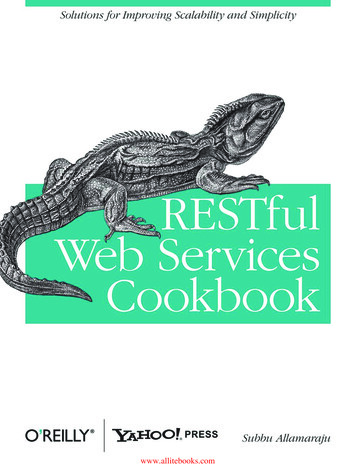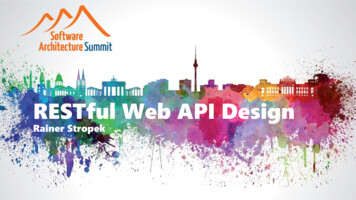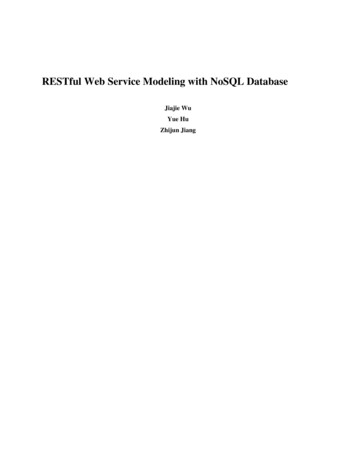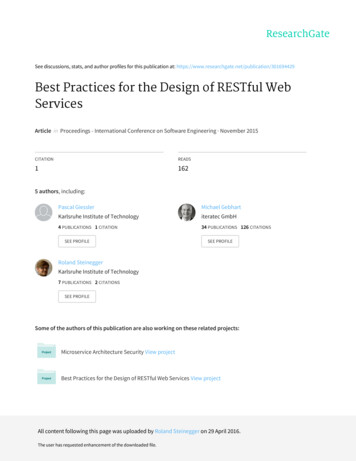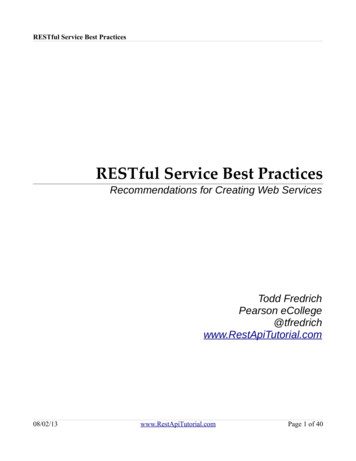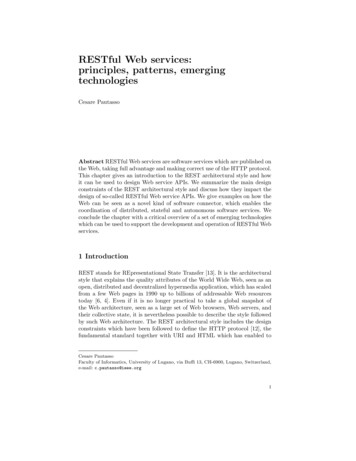
Transcription
RESTful Web services:principles, patterns, emergingtechnologiesCesare PautassoAbstract RESTful Web services are software services which are published onthe Web, taking full advantage and making correct use of the HTTP protocol.This chapter gives an introduction to the REST architectural style and howit can be used to design Web service APIs. We summarize the main designconstraints of the REST architectural style and discuss how they impact thedesign of so-called RESTful Web service APIs. We give examples on how theWeb can be seen as a novel kind of software connector, which enables thecoordination of distributed, stateful and autonomous software services. Weconclude the chapter with a critical overview of a set of emerging technologieswhich can be used to support the development and operation of RESTful Webservices.1 IntroductionREST stands for REpresentational State Transfer [13]. It is the architecturalstyle that explains the quality attributes of the World Wide Web, seen as anopen, distributed and decentralized hypermedia application, which has scaledfrom a few Web pages in 1990 up to billions of addressable Web resourcestoday [6, 4]. Even if it is no longer practical to take a global snapshot ofthe Web architecture, seen as a large set of Web browsers, Web servers, andtheir collective state, it is nevertheless possible to describe the style followedby such Web architecture. The REST architectural style includes the designconstraints which have been followed to define the HTTP protocol [12], thefundamental standard together with URI and HTML which has enabled toCesare PautassoFaculty of Informatics, University of Lugano, via Buffi 13, CH-6900, Lugano, Switzerland,e-mail: c.pautasso@ieee.org1
2Cesare Pautassobuild the Web [5]. These constraints make up the REST architectural styleand have been distilled by Roy Fielding in his PhD dissertation [11].Over the last decade, the Web has grown from a large-scale hypermediaapplication for publishing and discovering documents (i.e., Web pages) into aprogrammable medium for sharing data and accessing remote software components delivered as a service. As the Web became widespread, TCP/IP port80 started to be left open by default on most Internet firewalls, making itpossible to use the HTTP protocol [12] (which by default runs on port 80) asa universal mean for tunneling messages in business to business integrationscenarios. RESTful Web services — as opposed to plain (or Big [22]) Webservices — emphasize the correct and complete use of the HTTP protocol topublish software systems on the Web [24]. More and more services publishedon the Web are claiming to be designed using REST. As we are going to discuss, even if all make use of the HTTP protocol natively, not all of them do soin full compliance with the constraints of the REST architectural style [16].In this chapter we present how the Web can be seen as a novel kind ofsoftware connector, which enables the coordination of distributed, statefuland autonomous software services. We summarize the main design constraintsof the REST architectural style and discuss how they impact the design ofso-called RESTful Web service APIs. We conclude the chapter with a criticaloverview of a set of emerging technologies which can be used to support thedevelopment and operation of RESTful Web services.2 PrinciplesUnderstanding the architectural principles underlying the World Wide Webcan lead to improving the design of other distributed systems, such as integrated enterprise architectures. This is the claim of RESTful Web services,designed following the REST architectural style [11], which emphasizes thescalability of component interactions, promotes the reuse and generality ofcomponent interfaces, reduces coupling between components, and makes useof intermediary components to reduce interaction latency, enforce security,and encapsulate legacy systems.2.1 Design ConstraintsThe main design constraints of the REST architectural style are: global addressability through resource identification, uniform interface shared by allresources, stateless interactions between services, self-describing messages,and hypermedia as a mechanism for decentralized resource discovery by referral.
RESTful Web services: principles, patterns, emerging technologies31. Addressability All resources that are published by a Web service shouldbe given a unique and stable identifier [17]. These identifiers are globallymeaningful, so that no central authority is involved in minting them, andthey can be dereferenced independently of any context. The concept ofa resource is kept very general as REST intentionally does not make anyassumptions on the corresponding implementation. A resource can be usedto publish some service capability, a view over the internal state of aservice, as well as any source of machine-processable data, which mayalso include meta-data about the service.2. Uniform Interface All resources interact through a uniform interface, whichprovides a small, generic and functionally sufficient set of methods to support all possible interactions between services. Each method has a welldefined semantics in terms of its effect on the state of the resource. Inthe context of the Web and its HTTP protocol, the uniform interfacecomprises the methods (e.g., GET, PUT, DELETE, POST, HEAD, OPTIONS, etc.) that can be applied to all Web resource identifiers (e.g., URIswhich conform to the HTTP scheme). The set of methods can be extendedif necessary (e.g., PATCH has been recently proposed as an addition todeal with partial resource updates [8]) and other protocols based on HTTPsuch as WebDAV include additional methods [14]3. Stateless Interactions Services do not establish any permanent session between them which spans across more than a single interaction. This ensuresthat requests to a resource are independent from each other. At the endof every interaction, there is no shared state that remains between clientsand servers. Requests may result in a state change of the resource, whosenew state becomes immediately visible to all of its clients.4. Self-Describing Messages Services interact by exchanging request and response messages, which contain both the data (or the representations ofresources) and the corresponding meta-data. Representations can vary according to the client context, interests and abilities. For example, a mobileclient can retrieve a low-bandwidth representation of a resource. Likewise,a Web browser can request a representation of a Web page in a particular language, according to its user preferences. This greatly enhances thedegree of intrinsic interoperability of a REST architecture, since a clientmay dynamically negotiate the most appropriate representation format(also called media type) with the resource as opposed to forcing all clientsand all resources to use the same format. Request and response messagesalso should contain explicit meta-data about the representation so thatservices do not need to assume any kind of out-of-band agreement on howthe representation should be parsed, processed and understood.5. Hypermedia Resources may be related to each other. Hypermedia is aboutembedding references to related resources inside resource representationsor in the corresponding meta-data. Clients can thus discover the identifiers (or hyper-links) of related resources when processing representationsand choose to follow the link as they navigate the graph built out of rela-
4Cesare Pautassotionships between resources. Hypermedia helps to deal with decentralizedresource discovery and is also used for dynamic discovery and descriptionof interaction protocols between services. Despite its usefulness, it is alsothe constraint that has been the least used in most Web service APIsclaiming to be RESTful. Thus, sometimes Web service APIs which alsocomply with this constraint are also named “Hypermedia APIs” [3].2.2 Maturity ModelThe main design constraints of the REST architectural style can also beadopted incrementally, leading to the definition of a maturity model forRESTful Web services as proposed by Leonard Richardson. This has led toa discussion on whether only services that are fully mature can be actuallycalled RESTful. In the state of the practice, however, many services whichare classified in the lower levels of maturity already present themselves asmaking use of REST. Level 0: HTTP as a tunnel These are all services which simply exchangeXML documents (sometimes referred to as Plain-Old-XML documents asopposed to SOAP messages) over HTTP POST request and responses,effectively following some kind of XML-RPC protocol [28]. A similar approach is followed by services which replace the XML payloads with JSON,YAML or other formats which are used to serialize the input and output parameters of a remote procedure call, which happens to be tunneledthrough an open HTTP endpoint. Even if such services are not makinguse of SOAP messages, they are not really making full use of the HTTPprotocol according to the REST constraints either. In particular, since allmessages go to the same endpoint URL, a service can distinguish betweendifferent operations only by parsing such information out of the XML (orJSON) payload. Level 1: Resources As opposed to using a single endpoint for tunnelingRPC messages through the HTTP protocol, services on maturity level 1make use of multiple identifiers to distinguish different resources. Eachinteraction is addressed to a specific resource, which can however still bemisused to identify different operations or methods to be performed onthe payload, or to identify different instances of object of a given class, towhich the request payload is addressed. Level 2: HTTP Verbs In addition to fine-grained resource identification,services of maturity level 2 also make proper use of the REST uniforminterface in general and of the HTTP verbs in particular. This means thatnot only clients can perform a GET, DELETE, PUT on a resource, in addition to POSTing to it, but also do so in compliance with the semantics ofsuch methods. For example, service designers ensure that GET, PUT andDELETE requests to their service are idempotent. Since we can assume
RESTful Web services: principles, patterns, emerging technologies5that the HTTP methods are used according to their standard semantics,we can use the corresponding safety and idempotency properties to optimize the system by introducing intermediaries. For example, the resultsof safe and side-effect free GET requests can be cached and failed PUTand DELETE requests can be automatically retried. Additionally, servicesmake use of HTTP status codes correctly to, e.g., indicate whether methods are applicable to a given resource or to assign blame between whichparty is responsible for a failed interaction. Level 3: Hypermedia These are the fully mature RESTful Web services,which in addition to exposing multiple addressable resources which sharethe same uniform interface also make use of hypermedia to model relationship between resources. This is achieved by embedding so-called hypermedia controls within resource representations [19]. Depending on the chosenmedia type, hypermedia controls such as links or forms can be parsed,recognized and interpreted by clients to drive their navigation within thegraph of related resources. Hypermedia controls will be typed according tothe semantics of the relationship and contain all information necessary fora client to formulate a request to a related resource. As opposed to knowing in advance all the addresses of the resources that will be used, a clientcan thus dynamically discover with which resource it should interact byfollowing links of a certain type. Key to achieving this level of maturity isthe choice of media types which support hypermedia controls (e.g., XMLor JSON do not, while ATOM, XHTML or JSON-LD do.). The abilityof a service to change the set of links that are given to a client based onthe current state of a resource is also known with the ugly HATEOAS(Hypertext As The Engine Of Application State) acronym, to which nowthe simpler “hypermedia” term is preferred [23].The maturity level of a service also affects the quality attributes of thearchitecture in which the service is embedded. Tunneling messages throughan open HTTP port (level 0) leads only to the basic ability to communicateand exchange data, but – security issues notwithstanding – is likely to resultin brittle integrated systems, which are difficult to evolve and scale. Distinguishing multiple resources helps to apply divide and conquer techniques tothe design of a service interface and enable services to use global identifiers toaddress each resource that is being published. Applying a standardized anduniform interface to each resource removes unnecessary variations (as thereare only a few universally accepted methods applicable to a resource) and enables all services to interact with all resources within the architecture, thuspromoting interoperability and serendipitous reuse [29]. Additionally the semantics of the methods that make up the uniform interface can be adjustedso that the scalability and reliability of the architecture are enhanced. However, only the dynamic discoverability of resources provided by hypermediacontributes to minimize the coupling within the resulting architecture.
6Cesare Pautasso2.3 Comparing REST vs. WS-*The maturity model can also be used to give a rough comparison betweenRESTful Web services and WS-* Web Services (Figure 1). A more detailedcomparison can be found in [22].As the maturity level increases, the service will switch from using a singlecommunication endpoint to many URIs (on the resource identification axis).Likewise, the set of possible methods (or operations) will be limited to theones of the uniform interface as opposed to designing each service with its ownset of operations explicitly described in a WSDL document. From a RESTperspective, all WSDL operations are tunneled through a single HTTP verb(POST), thus reducing the expressiveness of HTTP seen as an applicationprotocol, which is used as a transport protocol for tunneling messages. InWSDL several communication endpoints can be associated with the sameservice although these endpoints are not intended for distinguising HTTPresources but may be used to access the same service through alternativecommunication mechanisms.The third axis is not directly reflected in the maturity model but is also important for understanding the difference between the two technology stacks,one having a foundation in the SOAP protocol and the XML format, whilethe other leaves open the choice of which message format should be used(shown on the representations axis) so that clients and services can negotiatethe most suitable format to achieve interoperability.Fig. 1 Design Space: RESTful Web Services vs. WS-* Web Services
RESTful Web services: principles, patterns, emerging technologies73 ExampleAs inspiration for this example we use the Doodle REST API, whichgives programmatic access to the Doodle poll Web service available at(http://www.doodle.ch). Doodle is a very popular service, which allows tominimize the number of emails exchanged in order to find an agreementamong a set of people. The service allows to initiate polls by configuring aset of options (which can be a set of dates for scheduling a meeting, butcan also be a set of arbitrary strings). The link to the poll is then mailedout to the participants, who are invited to answer the poll by selecting thepreferred options. The current state of the poll can be polled at any time bythe initiator, who will typically inform the participants of the outcome witha second email message.Fig. 2 Simple Doodle REST APIThe Simple Doodle REST API (Figure 2) publishes two kinds of resources:polls (a set of options once can choose from) and votes (choices of peoplewithin a given poll). There is a natural containment relationship betweenthe two kinds of resources, which fits naturally into the convention to use/ as a path separator in URIs. Thus the service publishes a /poll rootresource, which contains a set of /poll/{id} poll instances, which includethe corresponding set of votes /poll/{id}/vote/{id}.
8Cesare Pautasso3.1 Listing active pollsThe root /poll resource is used to retrieve (with GET) the list of links tothe polls which have been instantiated: GET /pollAccept: text/uri-list 200 OKContent-Type: 2012050113.2 Creating new pollsThe same /poll resource acts as factory resource which accepts POST requests to create new poll instances. The identifier of the newly created pollis returned as a link associated with the Location response header. POST /pollContent-Type: application/xml options A,B,C /options 201 CreatedLocation: /poll/2012050123.3 Fetching the current state of a pollThe current state of a poll instance can be read with GET, modified withPUT (e.g., to change the set of possible options or to close the poll). Pollinstances can also be removed with DELETE. GET /poll/201205012Accept: application/xml
RESTful Web services: principles, patterns, emerging technologies9 200 OKContent-Type: application/xml poll options A,B,C /options votes href "/poll/201205012/vote"/ /poll The representation of a newly created poll resource, in addition to the setof options provided by the client, also contains a link to the resource usedto cast votes. Clients can follow the link to express their opinion and makea choice. The nested vote resource acts as a factory resource for individualvotes.3.4 Casting votes POST /poll/201205012/voteContent-Type: application/xml vote name C. Pautasso /name choice B /choice /vote 201 CreatedLocation: /poll/201205012/vote/1After the previous request has been processed a new vote has been castand the state of the poll has changed. Retrieving it will now return a differentrepresentation, which includes the information about the vote. GET /poll/201205012Accept: application/xml 200 OKContent-Type: application/xml poll options A,B,C /options votes href "/poll/201205012/vote" vote id "1" name C. Pautasso /name choice B /choice /vote /votes /poll
10Cesare Pautasso3.5 Changing votesSince each vote gets its own URI it is also possible to manipulate its state withPUT and DELETE. For example, clients may want to retract a vote (withDELETE) or modify the choice (with PUT) as in the following example. PUT /poll/201205012/vote/1Content-Type: application/xml vote name C. Pautasso /name choice C /choice /vote 200 OK3.6 Interacting with votesIn general, it is not always possible nor it is necessary for a resource to respond to requests which make use of all possible methods of the uniforminterface. In the context of the Simple Doodle REST API, as shown in Figure 2, it has been chosen not to support PUT and DELETE on the /polland /poll/{id}/vote resources. Also POST requests to individual instances/poll/{id} or /poll/{id}/vote/{id} are not supported. Such requests donot have a meaningful effect on the state of the resource and are thus disallowed. Clients attempting to issue them will receive an erroneous response: POST /poll/201205012/vote/1 405 Method not allowedClients can also inquire which methods are allowed before attempting toperform them on a resource making use of the OPTIONS method as follows OPTIONS /poll/201205012/vote/1 204 No ContentAllow: GET, PUT, DELETEAn OPTIONS request will return a list of the methods which are currentlyapplicable to a resource in the response Allow header. The set of allowedmethods may change depending on the state of the resource.
RESTful Web services: principles, patterns, emerging technologies113.7 Removing a pollOnce a poll has received enough votes and a decision has been made, its statewill be kept indefinitely by the service until an explicit request to remove itis made by a client. DELETE /poll/201205012 200 OKSubsequent requests directed to the delete poll instance will also receivean erroneous response. GET /poll/201205012 404 Not Found4 PatternsOnce the basic architectural principles for the design of RESTful Web servicesare established, it remains sometimes difficult to apply them directly to thedesign of specific Web service APIs. In this Section we collect a small numberof design patterns, which provide some guidance on how to deal with resourcecreation, long running operations and concurrent updates. Additional knownpatterns address features such event notifications, enhancing the reliabilityof interactions, atomicity and transactions and supporting the evolution ofservice interfaces. In general, applying one of these patterns requires to makeuse of some existing feature of the standard HTTP protocol, which may needto be augmented with some conventions and shared assumptions on howto interpret its status code and headers. The current understanding withinthe REST community is that it should be possible to design fully functionalservice APIs that do not require any non-standard extension to the HTTPprotocol.The example patterns included in this chapter is not intended to be complete, for additional guidance on how to design RESTful Web services, werefer the interested reader to [1, 7, 10, 25, 30].4.1 Resource creationThe instantiation of resources is a key feature of most RESTful Web services,which enable clients to create new resource identifiers and set the corresponding state to an initial value. The resource identifier can either be set by theclient or by the service. It is easier to guarantee that URIs created by the
12Cesare Pautassoservice are unique, while it is possible that multiple clients will generate thesame identifier.When using a single HTTP interaction to create a resource, there are twopossible verbs that can be used: PUT or POST. The basic semantics of PUTrequests is to update the state of the corresponding resource with the provided payload. If no resource is found with the given identifier, a new resourceis created. This has the advantage of using idempotent requests to create aresource, but requires clients to avoid mixing up resource identifiers. POSTon the other hand assumes that the server will create a new resource identifier. Since POST is not idempotent, there have been a number of patternsthat have been proposed to address this limitation and avoid the so-called“duplicated POST submission” problem. The convention is to use some kindof “factory” resource, to which POST requests are directed for creating newresources. However, repeating such requests in case of failure would lead topotentially multiple, different instances to be created by the factory.The pattern is based on the idea of splitting the centralized generation ofthe new resource identifier on the service-side from the initialization of itsstate with the payload provided by the client. The pattern makes combinedusage of both POST and PUT requests as follows. POST /factory Empty Payload 303 See OtherLocation: /factory/id PUT /factory/id Initialization Payload 200 OKThe first POST request returns a new unique resource identifier /factory/idbut does not initialize its corresponding resource since the payload is empty.The second request PUTs the initial state on the new resource. In the worstcase, failures during the first POST request will lead to lost resource identifiers, which however can be garbage collected by the server since the corresponding resource has not been initialized. Likewise, clients may fail betweenthe two requests and thus could forget to follow up with the PUT request.The designer of the service needs to make reasonable assumptions on themaximum allowed delay between the two interactions. If a client is too lateand the resource identifier has been already garbage collected by the server,then another one can be simply retrieved by repeating the first POST request.Variations of this pattern have been proposed which replace the initialPOST with a GET request, which in the same way returns a new uniqueidentifier every time it is invoked. Similarly, the response payload of the firstrequest could be used to provide the client with a representation template,i.e., a form to be completed with the information required to initialize thenew resource.
RESTful Web services: principles, patterns, emerging technologies134.2 Long Running OperationsHTTP is a client/server protocol which does not assume that every requestis followed by a response indicating that the work has completed. For longrunning operations, which may result in a timeout of the network communication, it is possible to break the connection and avoid blocking the clientfor too long. This is particularly useful to invoke service operations that –depending on the size of the input provided by clients or by the complexity of their internal implementation – may require a long time to completeprocessing it.The pattern is based on turning the long running operation into a resource,whose identifier can be returned immediately to the client submitting thecorresponding job. POST /jobInput data payload 202 AcceptedContent-Location: /job/201205019 job status pending /status message Your job has been queued for processing /message ping-time 2012-05-01T05:22:12Z /ping-time /job The 202 Accepted status code implies that the service has verified therequest input payload and has accepted it, but no immediate response canbe given. The client should follow the link given in the Content-Locationheader to inquire (with GET) about the status of the pending request. GET /job/201205019 200 OK job status processing /status message Your job is being processed /message ping-time 2012-05-01T06:22:09Z /ping-time /job Clients can send GET requests to the job resource at any time to trackits progress. In addition to the status, the response also contains a hint (inthe ping-time element) on when the next poll request should be performedin order to reduce network traffic and service load due to excessive polling.Once the job has been completed, the response to the poll request willredirect the client to another resource from which the final result can beretrieved. GET /job/201205019
14Cesare Pautasso 303 See OtherLocation: /job/201205019/output job status done /status message Your job has been successfully completed /message /job The client can then follow the link found in the Location header to retrieve(with GET) the output of the completed job. The link could also be sharedamong different clients interested in reading the output of the original POSTrequest. GET /job/201205019/output 200 OKOutput data payloadIn case the client is no longer interested in retrieving the results, it is possible to cancel the resource job and thus remove it from the queue of pendingrequests. The client thus issues a DELETE request on the job resource, whichwill be allowed as long as the job has not yet completed its execution. DELETE /job/201205019 200 OKAfter a request has completed it is no longer possible to cancel it. In thiscase, a similar DELETE request can be performed on the resource representing the output results of the job when the client has completed downloadingthem and it is no longer interested in keeping the results stored on the server. DELETE /job/201205019/output 200 OKIf clients do not remember to clean up after themselves the server can endup storing a copy of all long running requests and potentially run out of space.Still, a garbage collection mechanism can be implemented to automaticallyremove old results through the same DELETE request.This pattern shows how to deal with long running operations by applyinga general design principle of turning “everything into a resource” [24]. In thiscase the resource represents the long running request which is managed bythe client through the HTTP uniform interface.
RESTful Web services: principles, patterns, emerging technologies154.3 Optimistic LockingRESTful Web services are stateful services, which associate to each resourceURI a representation which is produced based on the current state of the corresponding resource. It is thus important to deal with concurrent state modifications without violating the stateless constraint, which prevents clientsto establish a session with a service in which the resource is updated. Theproblem addressed by this pattern is thus the one of dealing with concurrentresource updates in compliance with the stateless constraint. The solutionadopted by the HTTP protocol makes use of a form of optimistic locking, asfollows.1. The client retrieves the current state of a resource. GET /resource 200 OKETag: 1Current representationTogether with the representation of the resource, the client is given throughthe ETag header some meta-data which identifies the current version of theresource.2. The client updates the state of a resource. While doing so, the client usesthe If-Match header to make the request conditional. PUT /resourceIf-Match: 1New representation 200 OKETag: 2Updated representationThe server will execute the PUT request only if the version of the resource(on the server-side) matches the version provided within the client request.If there is a mismatch, another client has already updated the resource inthe meanwhile and an update conflict has been detected. This is indicatedusing the standard 409 Conflict status code. To recover the client shouldstart again from step 1. by retrieving the latest state of the resource. Afterrecomputing the change locally, the client can once again attempt to updatethe resource.As with most optimistic protocols, this solution works well if the ratio ofupdates (PUT or POST) to reads (GET) is small. The pattern should not beused for resources that are hotly contested between multiple clients, or incase the cost of re-trying a failed update is expensive.
16Cesare Pautasso5 TechnologiesOver the past few
RESTful Web services: principles, patterns, emerging technologies Cesare Pautasso Abstract RESTful Web services are software services which are published on the Web, taking full advantage and making correct use of the HTTP protocol. This chapter gives an introduction to the REST architectural style and how it can be used to design Web service APIs.
